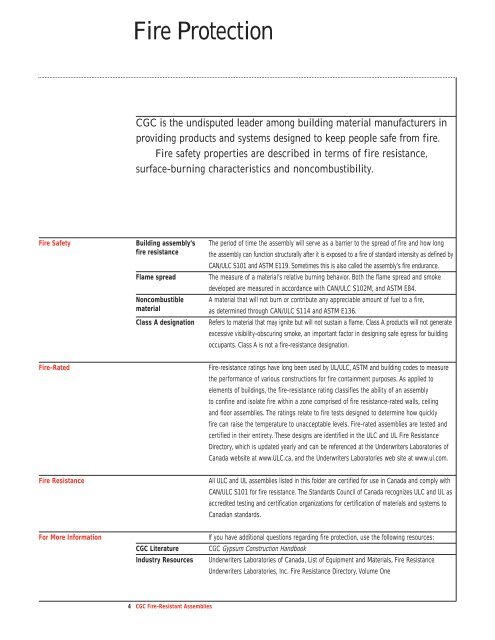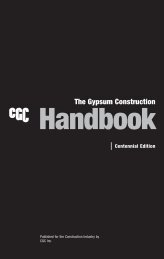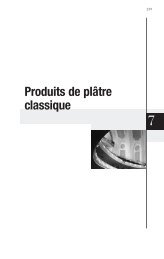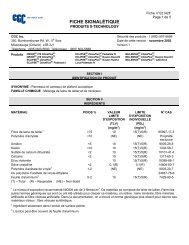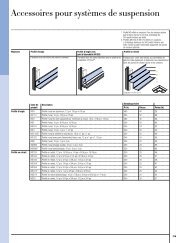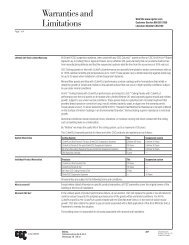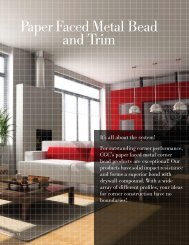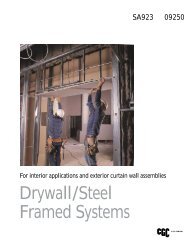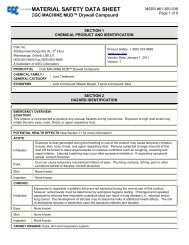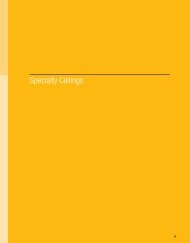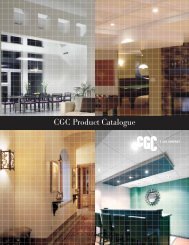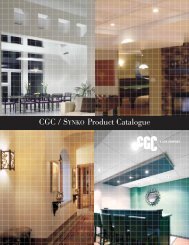Fire-Resistant Assemblies SA-100 - CGC
Fire-Resistant Assemblies SA-100 - CGC
Fire-Resistant Assemblies SA-100 - CGC
You also want an ePaper? Increase the reach of your titles
YUMPU automatically turns print PDFs into web optimized ePapers that Google loves.
<strong>Fire</strong> Protection<br />
<strong>CGC</strong> is the undisputed leader among building material manufacturers in<br />
providing products and systems designed to keep people safe from fire.<br />
<strong>Fire</strong> safety properties are described in terms of fire resistance,<br />
surface-burning characteristics and noncombustibility.<br />
<strong>Fire</strong> Safety Building assembly’s The period of time the assembly will serve as a barrier to the spread of fire and how long<br />
fire resistance the assembly can function structurally after it is exposed to a fire of standard intensity as defined by<br />
CAN/ULC S101 and ASTM E119. Sometimes this is also called the assembly’s fire endurance.<br />
Flame spread The measure of a material’s relative burning behavior. Both the flame spread and smoke<br />
developed are measured in accordance with CAN/ULC S102M, and ASTM E84.<br />
Noncombustible A material that will not burn or contribute any appreciable amount of fuel to a fire,<br />
material as determined through CAN/ULC S114 and ASTM E136.<br />
Class A designation Refers to material that may ignite but will not sustain a flame. Class A products will not generate<br />
excessive visibility-obscuring smoke, an important factor in designing safe egress for building<br />
occupants. Class A is not a fire-resistance designation.<br />
<strong>Fire</strong>-Rated <strong>Fire</strong>-resistance ratings have long been used by UL/ULC, ASTM and building codes to measure<br />
the performance of various constructions for fire containment purposes. As applied to<br />
elements of buildings, the fire-resistance rating classifies the ability of an assembly<br />
to confine and isolate fire within a zone comprised of fire resistance-rated walls, ceiling<br />
and floor assemblies. The ratings relate to fire tests designed to determine how quickly<br />
fire can raise the temperature to unacceptable levels. <strong>Fire</strong>-rated assemblies are tested and<br />
certified in their entirety. These designs are identified in the ULC and UL <strong>Fire</strong> Resistance<br />
Directory, which is updated yearly and can be referenced at the Underwriters Laboratories of<br />
Canada website at www.ULC.ca, and the Underwriters Laboratories web site at www.ul.com.<br />
<strong>Fire</strong> Resistance All ULC and UL assemblies listed in this folder are certified for use in Canada and comply with<br />
CAN/ULC S101 for fire resistance. The Standards Council of Canada recognizes ULC and UL as<br />
accredited testing and certification organizations for certification of materials and systems to<br />
Canadian standards.<br />
For More Information If you have additional questions regarding fire protection, use the following resources:<br />
<strong>CGC</strong> Literature <strong>CGC</strong> Gypsum Construction Handbook<br />
Industry Resources Underwriters Laboratories of Canada, List of Equipment and Materials, <strong>Fire</strong> Resistance<br />
Underwriters Laboratories, Inc. <strong>Fire</strong> Resistance Directory, Volume One<br />
4 <strong>CGC</strong> <strong>Fire</strong>-<strong>Resistant</strong> <strong>Assemblies</strong>


